Introduction
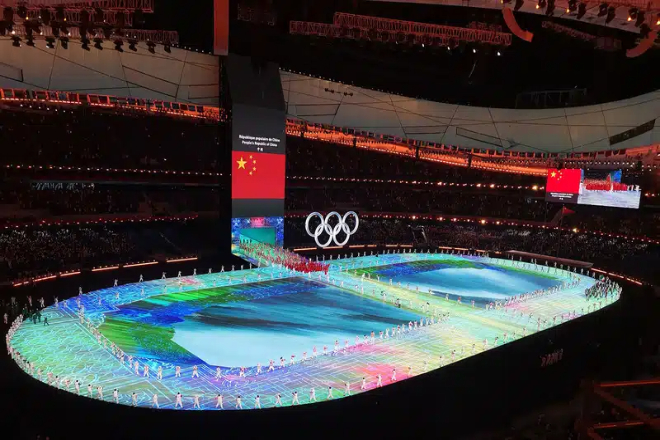
Do you know floor LED displays? Some people may wonder why some floor LED displays have interactive reactions when stepped on, but some do not?
In fact, they are different types of floor LED displays. It is divided into interactive and non-interactive. So, when faced with such a variety of choices, how can we choose the floor LED display that suits us best?
1. Basic introduction to floor LED displays
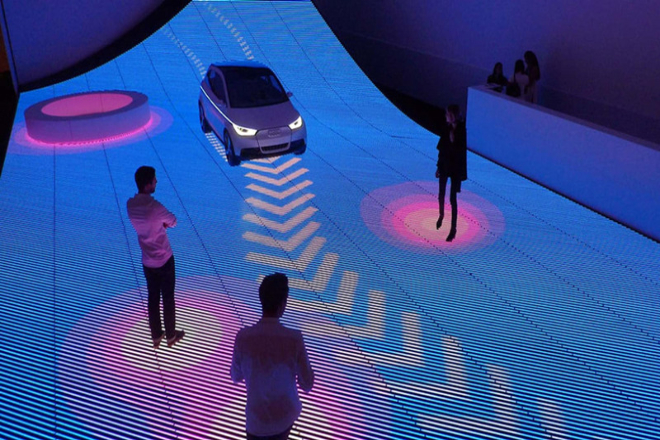
In simple terms, floor LED displays are a magical device that can be installed on the ground to display all kinds of cool videos, pictures and texts. It consists of a bunch of small LED lamp beads, each of which can emit light, like small pixels.
By controlling the on and off and brightness of these lamp beads, various pictures can be created.
The floor LED display is actually quite complicated. There are LED modules responsible for emitting light, power supplies to provide power, and boxes to protect the parts inside to prevent them from getting hurt.
If it is an interactive floor tile screen, there will be an additional sensor chip to capture our interaction with it.
1). What types are there?
There are two types of floor LED displays, one is interactive and the other is non-interactive. The non-interactive one is like a quiet audience, only responsible for playing the preset content.
The interactive one is like a lively friend, who will change different pictures according to our actions and reactions and play with us.
Interactive floor screens are more fun and attractive than non-interactive ones. It can make our actions and reactions become part of the picture, making us feel like we are walking into the picture.
For example, in a shopping mall, the interactive floor tile screen can display different advertisements or game pictures according to how we walk and jump, making our shopping more interesting.
2. Advantages and application scenarios of interactive floor LED display
1). Advantage analysis
1.1). Improved user experience brought by interactivity:
An interactive floor LED display is simply a paradise for fun! When you walk on it, every step may trigger a different picture, and it feels like you have become a magician who can control the changes on the ground.
This kind of interactivity really makes people feel involved and the fun rises sharply.
Imagine dancing to the rhythm of music in a nightclub or on stage, and the LED screen on the ground also changes with your movements. The immersion and fun are simply indescribable!
1.2). Real-time data feedback and dynamic content display:
Another cool feature of the interactive floor LED display is that it can provide real-time data feedback and dynamically display content.
For example, in a shopping mall, it can automatically adjust the displayed advertisements according to the customer flow and walking path.
It will show you the special offers in the area you walk to. Isn’t it super considerate? In stage performances, it can perfectly match music and lighting and show different visual effects as the rhythm changes, which is dazzling.
1.3). The charm of the mix of technology and art:
Moreover, the interactive floor LED display is a perfect combination of technology and art.
It can not only display high-definition and gorgeous images and videos, but also integrate your movements and reactions into it to create a unique work of art.
This mix not only enhances the viewing value of the displayed content, but also increases the fun, which is really eye-opening!
2). Application scenarios
2.1). Entertainment venues (such as stages, nightclubs):
In entertainment venues, interactive floor LED displays are simply magical! On the stage, dancers can perform more dazzling dances as the ground changes, and the audience will be more engaged because of this novel visual effect.
In nightclubs, floor screens can change according to the rhythm of the music, showing all kinds of cool patterns and colors, making the entire nightclub full of carnival atmosphere.
This application not only makes entertainment venues more attractive but also makes customers have more fun!
2.2). Commercial display (such as product launch, exhibition):
In commercial displays, interactive floor LED displays also shine. At product launch conferences, it can show the characteristics and advantages of products and attract the audience’s attention.
At exhibitions, it can dynamically adjust the displayed patterns and information according to the theme and content of the exhibition, allowing the audience to have a deeper understanding of the content of the exhibition.
This application not only enhances the attractiveness of commercial displays but also allows companies to better display and promote their products.
2.3). Public art installations:
Also, interactive floor LED displays can be seen in public art installations. In public places such as city squares and parks, it can display various artistic patterns and animations, allowing citizens to appreciate art while also feeling the charm of technology.
Children can play on it and trigger different images and sounds, which is really interesting and educational. This application not only enhances the cultural atmosphere of public places but also makes the lives of citizens more colorful!
In general, interactive floor LED displays are widely used in entertainment venues, commercial displays, public art installations and other fields with their unique interactive and real-time advantages.
It not only makes the venue more attractive and interesting, but also makes people’s lives more colorful!
3. Characteristics and scope of application of non-interactive floor LED displays
1). Overview of characteristics
1.1). Stability and durability:
When it comes to non-interactive floor LED displays, the stability is awesome! Unlike those interactive ones, it has to deal with various complex signals at every turn. It simply displays the content, so the system is particularly stable, and there is almost no failure.
Whether it is windy and rainy, or people and cars are running over it, it can stick to its post and display the picture as always. Moreover, its material and structural design are very strong, and it will not break down after several years of use. It is really “stable as an old dog”!
1.2). Low-cost advantage:
The cost of non-interactive floor LED display is surprisingly low! Because it does not require those complicated interactive equipment, the manufacturing cost is saved a lot.
For merchants with limited budgets but want to improve the visual effects of the venue, this is simply a godsend! Moreover, it is very durable, and in the long run, the maintenance cost is also very low. It is really cost-effective!
1.3). Concentration of content display:
The non-interactive floor LED display is a dedicated “good kid.” Unlike those interactive ones, it has to distract itself to process user input. It displays content wholeheartedly, allowing you to focus completely on the picture.
This kind of concentration is perfect for occasions that want to convey clear information and create a specific atmosphere!
2). Scope of application
2.1). Outdoor advertising:
The non-interactive floor LED display is a great success in the field of outdoor advertising! You can see it everywhere in commercial streets, squares, and highways. It is like a tireless propagandist, showing advertising content 24 hours a day. Moreover, its brightness is very high, and its waterproof performance is also excellent.
It can maintain a clear display effect even in direct sunlight or rainy days. This not only brings a lot of exposure and customer traffic to businesses but also makes the city more colorful.
2.2). Indoor decoration:
Non-interactive floor LED display is also a good hand in interior decoration! It can be embedded in the ground and perfectly integrated with the indoor environment to display various exquisite patterns and videos.
Hotel lobbies, shopping malls, exhibition halls, and even living rooms at home can be decorated with it. It is like a magician which can instantly upgrade the space and make it more technological and artistic. Walking on such a ground is like enjoying a visual feast!
2.3). Signage:
Non-interactive floor LED display is also particularly suitable for use as signage! In public places such as airports, train stations, and subway stations, it is like a caring guide, clearly displaying directions, schedules, stations, and other information.
Its display effect is particularly clear, and it can maintain a stable display even if there is a large flow of people and the use environment is harsh. Moreover, its installation method is also very flexible. It can be embedded in the ground or installed on the wall, which provides great convenience for passengers.
In general, non-interactive floor LED display has a wide range of applications in outdoor advertising, interior decoration, signage, and other fields due to its stability, durability, low cost, and focus on content display.
It can not only meet our various content display needs but also beautify the environment and improve the overall quality of the venue. It is really a good choice that is both practical and beautiful!
4. Comparative analysis of interactive and non-interactive floor LED display
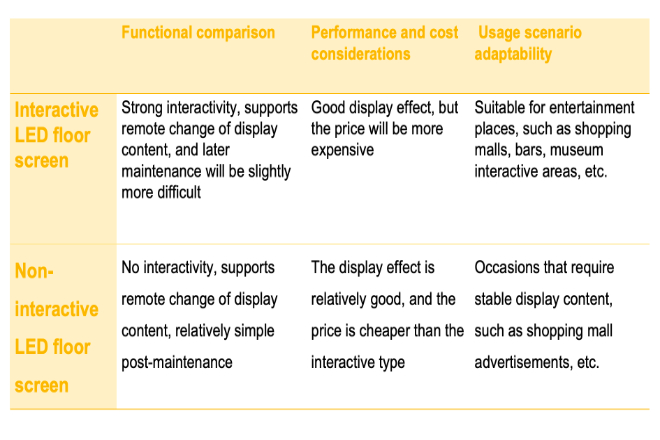
1). Function comparison
1.1). Interactivity:
The interactive floor LED display is simply a lively little rabbit, responding to you immediately when there is any movement. You step on it; it changes color; you wave your hand, and it changes the picture.
This interactive feeling makes people unable to stop playing, which is especially suitable for those occasions that want to attract the audience’s attention and let everyone participate.
The non-interactive floor LED display is like a quiet virgin. It displays the content in a rigid manner according to the set program. No matter how you tease it, it will ignore you.
1.2). Content update method:
When it comes to content updates, this is actually the same for both interactive and non-interactive LED floor tiles. It mainly depends on whether you choose asynchronous control or synchronous control when you purchase it in the early stage.
1.3). Maintenance cost:
In terms of maintenance cost, interactive and non-interactive floor LED displays have their own advantages. Because of the complex structure of the interactive one, once it breaks, it may cost some money to repair it.
But the advantage is that it is easy to update the content, and you don’t have to change it all the time, which may save you some money in the long run.
The non-interactive type has a simple structure and is cheap to repair, but it is not convenient to update the content, and you may have to change it frequently. If you calculate it this way, the cost is not low.
2). Performance and cost considerations
2.1). Performance:
In terms of performance, the interactive floor LED display has high brightness, clear resolution, and fast response time, just like an all-around player.
Although the non-interactive type may have slightly worse performance, it is completely sufficient for some occasions that only need to display simple content. It’s like if you buy a car, if it’s just for transportation, there’s no need to buy a sports car, right?
2.2). Cost:
In terms of cost, the non-interactive floor LED display is definitely cheaper. It has a simple structure and is easy to manufacture, so the price is naturally low.
As for the interactive type, because of the many technologies and complex equipment, the price is also high. So, which one to choose depends on whether your wallet is fat.
3). Adaptability to usage scenarios:
3.1). Interactive floor LED display:
Interactive floor LED display is the darling of entertainment and business occasions! Nightclubs, stages, product launches, these occasions need to attract the audience’s attention and let everyone have fun, it is definitely the right choice.
It can instantly ignite the atmosphere on the scene, let the audience participate, and have fun.
3.2). Non-interactive floor LED display:
Non-interactive floor LED display is more suitable for those occasions that need to display content stably.
For example, outdoor advertising and signage. These occasions do not require high interactivity, but pay more attention to the clarity and stability of the content. Non-interactive floor LED display is like a reliable old friend, always there to serve you steadily.
In general, interactive and non-interactive floor LED displays have their own advantages, and which one to choose depends on your needs and budget. Don’t blindly follow the trend, choosing the one that suits you is the most important!
5. Key factors for choosing floor LED display
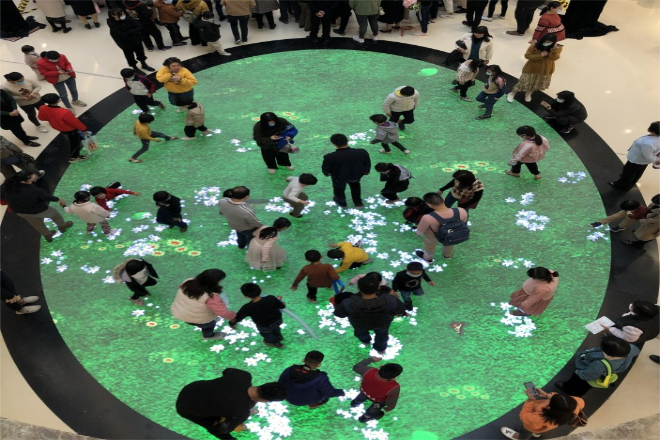
1). Project demand analysis:
When choosing a floor LED display, the first step is to clarify the project demand, which is crucial. You have to think about where this display will be used. Is it an outdoor square or an indoor shopping mall?
Who is the target audience? Is it young people or children? Also, what is the budget? You have to have an idea in mind.
If it is used outdoors, the display must be bright enough to withstand direct sunlight; if it is used indoors, the resolution must be high so that it looks clear.
If the target audience is young people, you may have to choose something with strong interactivity and many ways to play; if it is for children, the content must be simple and interesting.
As for the budget, of course, the more the better, but you have to do it within your means and don’t exceed your tolerance.
2). Technical evaluation:
Technical performance is the core of floor LED display. Brightness, resolution, refresh rate, all of these need to be carefully looked at. The brightness must be high enough to be clear in various light environments.
The resolution must be fine enough to make the picture vivid; the refresh rate must be fast to avoid screen freezes.
There is also interactive technology, which is popular now. You have to see whether this technology is mature and stable. Don’t let the display get stuck or go wrong when you interact with it, which is not good.
3). Supplier selection:
Choosing a supplier is not a sloppy thing. You have to shop around and compare to see which one is strong, has a good reputation, and has reliable after-sales service.
A strong supplier has guaranteed product quality; a good reputation is also safe to use; a reliable after-sales service can solve problems in time.
Don’t just listen to the supplier’s own boasting; you have to ask the customers who have used it to see what they say. If the customer says it’s good, then it’s really good.
4). Installation and maintenance considerations:
The installation and maintenance of floor LED display is also a big problem. You have to see whether the installation method is convenient, whether the maintenance is difficult, and whether the cost is high.
Some display screens are very troublesome to install and cost a lot of money to maintain, so you have to think about it carefully.
There is also long-term reliability, which is also very important. You have to choose those displays that can stand the test of time. Don’t use them for a while and they will break down.
That’s not worth it. So, you have to be more careful when choosing, read more product introductions and user reviews, and don’t place orders blindly.
In general, choosing a floor LED display is not an easy task. You have to clarify the project requirements, carefully evaluate the technical performance, compare suppliers, and consider installation and maintenance issues.
Only in this way can you choose a floor LED display that is both suitable and practical.
6. Future development of floor LED display
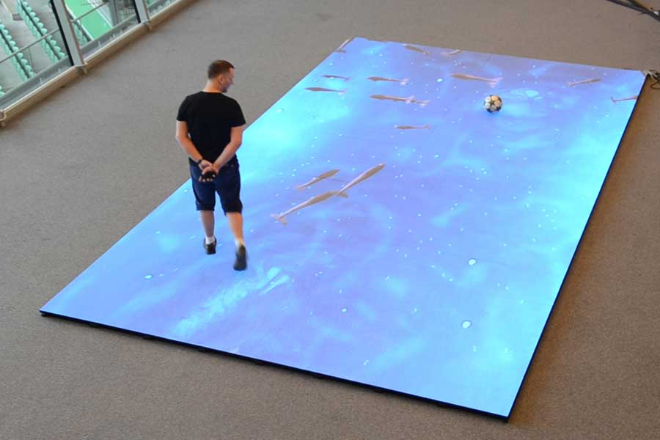
1). Technological innovation:
1.1). Display technology:
The display technology of floor LED display is definitely getting better and better! The brightness will be higher, so high that you can see it clearly even under the sun.
The resolution will also be finer, so fine that you can’t see the pixels even if you look closely. In the future, when we look at floor LED displays, it will be like looking at the real thing, and our eyes will light up!
1.2). Interactive technology:
Interactive technology is also a major attraction of floor LED display. In the future, it can not only understand what you say, but also understand your gestures. Do you want to change the picture? Just say a word or wave your hand!
Combined with those virtual reality and augmented reality technologies, wow, it’s like entering another world, it’s so fun!
Conclusion
Through the explanation of this article, I believe you have understood the basic concepts of floor LED display, the respective advantages of interactive and non-interactive, applicable scenarios, and key factors when choosing.
In fact, both interactive and non-interactive floor LED display have their unique charm and application value. The key to choosing the type of floor LED display is to clarify your project requirements.
Finally, if you want to know more about LED displays, please get in touch with us.
